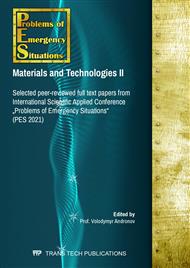p.317
p.323
p.330
p.336
p.345
p.352
p.361
p.374
p.383
Investigation of the Limit of Fire Resistance of a Steel Beam at Loss of Integrity of a Fire-Resistant Lining
Abstract:
In this article, to solve the main problems, we determined the temperature regime of heating the steel beam, which took into account the fact of loss of integrity of the fire-retardant lining due to the thermal effects of fire. When calculating the temperature, the time of exposure to the standard temperature of the fire and the value of the heating temperature of the steel beam with mineral wool lining at which the latter loses its integrity was determined. Taking into account the geometrical parameters of the cross section of the studied I-beam, according to the finite-element scheme, the steel beam was divided into four elements of SHELL type with five points of integration in thickness in the Belichko-Tsai formulation. After the calculation, the corresponding results were obtained in the form of graphs of changes in the maximum deflection of the beam and the rate of increase of the maximum deflection depending on the time of exposure to the standard temperature of the fire. The critical values of the occurrence of the limit of fire resistance according to the graph of maximum deflection and the graph of the rate of increase of deflection were determined. The difference between the indicators shows that the time of the limit state of loss of bearing capacity is 70 min less, if not taking into account the loss of fire-retardant capacity of mineral wool fire-protection due to loss of integrity.
Info:
Periodical:
Pages:
345-351
Citation:
Online since:
July 2021
Authors:
Price:
Сopyright:
© 2021 Trans Tech Publications Ltd. All Rights Reserved
Share:
Citation:


